Updated: 04-Jul-2022
Members of the American Rocketry Society founded this company in 1941 to build engines for future test vehicle programs, both missiles and aircraft.
-After succeeding with the engines that powered the first aircraft to pass the sound barrier, the Bell X-1, for the Douglas Skyrocket and for the famous X-15, the company was taken over by Thiokol Chemical in 1958 and today they both are at Morton-Thiokol.
-The first engine from Reaction Motors Inc. (RMI) was the 6000-C4, with 6,000 lbf of thrust.
-Another of the first Reaction Motors Inc. (RMI) engines is the one shown below, model M17G that ran on liquid oxygen and gasoline to give 590 Kgf of thrust. It was used as JATO and that was finally reconverted to use nitric acid and aniline.
-They were used, for example, on Catalina PBMs. The engine picture is taken at NASM.
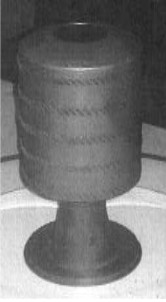
“M17G”
-For the Reaction Motors BB-1 pulse jet, documentation has been requested from Nasm. Doc. (BR-179500-01)
-These pounds of thrust are equal to 2,722 Kgf which is not too much.
-The engine has four combustion chambers, which we will also see in the XLR-11 and other engines of this brand.
-We can see the valve body and notice the absence of the feed turbopumps since this is done by pressurizing the tanks with helium or nitrogen.

“RMI-6000C4”
-Chamber and nozzle cooling is done by the fuel that circulates around them. It is a so-called regenerative system.
-The RMI LR2-RM1, similar, would give way to the LR6 and LR8 and their variants. The LR6 was installed on the Lark. We see an illustration of the LR8-RM6. The same engine but RM5 was from 1958, running on LOX and alcohol, with four chambers. It was mounted on the Bell X-1-E.

“LR8-RM6”
-The LR10-RM1, the same in architecture, was mounted on the Viking RTV-N12.
-The most successful would be the XLR-11, perhaps because it was mounted on the X-15 plane that was famous for its speed records.
-The XLR-99 or LR-99 was also successful after its experimental time. The -99 was known as "Pioneer", and it was already a single-chamber engine.
-It used liquid oxygen and anhydrous ammonia as fuel, with 22/30,000 Kgf of thrust.
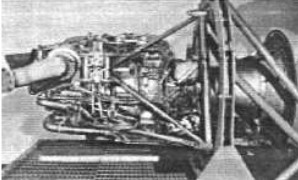
“XLR-99”
-The turbo pumps for fuel and oxidant worked with turbines that use the monopropellant hydrogen peroxide.
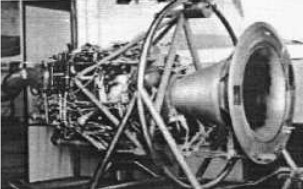
“SLR-99-RM2”
-The SLR-99 variant developed 27,000 Kgf of thrust. They were also installed on the X-15. Although the most used engine was the XLR-11.
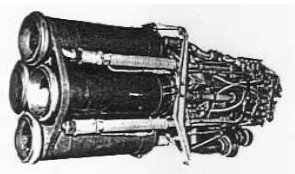
“XLR-11-RM5”
-On the X-15, the XLR-11 was double mounted as we see below.

“Double XLR-15”
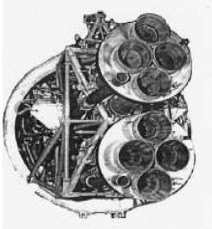
“Double assembly rear view”
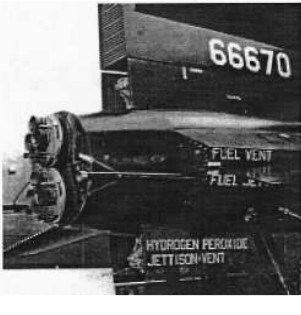
“The two XLR-11s on a X-15”
-In the early 1960's, double mounting was offered, one engine on top of the other (total 8 cameras). They were using ethyl alcohol and liquid oxygen again.
-The turbo pumps ran on hydrogen peroxide monopropellant as with the XLR-99.
In the above photograph we can see the X-15 with the outlet for the gases from the turbo-pump and tank ventilation in the lower part.
-The chamber arrangement is identical in both engines.
-The two engines are joined in a structure of the chromium-moly type which is typical for aviation engine mounts.
-It is attached to the plane by three fitting points.
-In any case, the tanks were pressurized. The LR-11-RM1 used nitrogen, the RM3 used helium and the RM5 hydrogen.
-For all three the fuel was 75% ethyl alcohol and 25% water, with liquid oxygen as oxidant.
-There were the lesser known LR-22 and LR26.
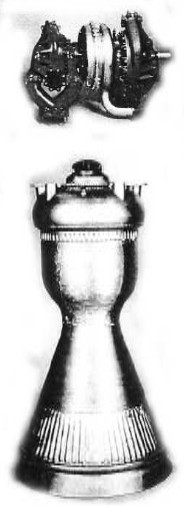
“XLR-30”
-Above the XLR-30 turbo pump and chamber are shown separately, and in the drawing below it is assembled.

“XLR-30 assembly schematics”
-The XLR-30RM2 was built from 1952 to 1957 using LOX/ammonia for the early X-15s. The XLR30 was canceled in favor of the XLR-99.
-The small XLR32-RM2 was put on the tips of the XH-15 helicopter blades. The LR-33 and LR-35 followed (in the late 1940's the data for these two were confidential).
-The XLR-39 was a small engine with only 50 lbf of thrust. It ran on LOX and alcohol. The XLR-40 and XLR-48 followed.
-As tests on other ideas, the well-known ROR or “Rocket On Rotor” are small motors installed at the ends of the main rotor blades.

“Sikorsky S-55 with ROR”
-These rockets gave 14 Kgf of thrust weighing only half a kilogram.
-They were tests carried out at the Anacostia naval base, and these rocket engines were planned for emergencies with autorotations. We don't know any other RMI engine application on helicopters in the USA.
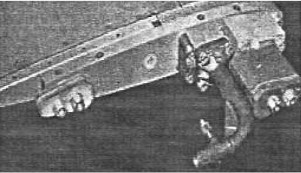
“RMI ROR engine”
-This small engine ran on hydrogen peroxide and produced an additional 120 total HP.
-This allowed to lengthen the autorotation, take off with a little more payload from sea level to just over 1500 meters high and hovering capacity at higher altitudes.
-The tank of this monopropellant was in the central mast and it had a duration of about 6 minutes of operation. As the rotor had three blades, each small motor gave 40 HP, the equivalent of 18.1 kg of thrust.
Authors Note: In England, the “Skeeter” helicopter tested a similar system, Ver Saro -Saunders Roe-.
-From Reaction Motors Inc, there is the engine used on the Gorgon 3a missile with the reference CML-2N, a liquid fuel rocket engine, where the monoehthyl-aniline was self-inflamed (hypergolic) with a mixture of sulfuric and nitric acid.
From Appendix 6: Reaction Motors Inc. made the ROR (rocket on rotor) test on a Sikorsky model HRS-2 helicopter, installing small rockets on the tips of the main rotor blades.
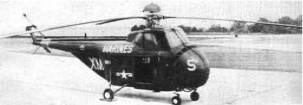
“Rocket system not only applicable to Sikorsky”
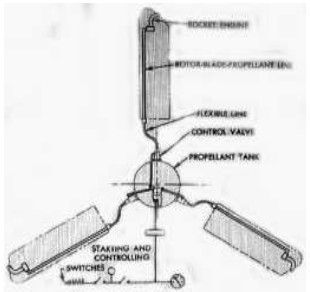
“RMI ROR schematic drawing”
-The rocket-propelled rotor is quieter, according to the tests that were carried out.
-We now see the XLR-11 engine installed on the XF-91 experimental aircraft.
-This four-chamber engine is located under the main turbine nozzle.
-It runs on liquid oxygen and alcohol based propellants.
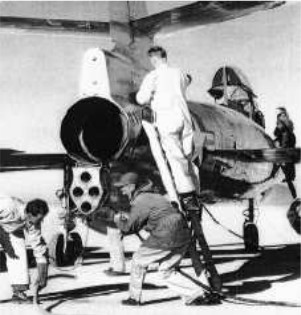
“Prepairing the XF-91”
-Another model from those years (1949) was the MX-774 project, with multiple chambers as well, but adjustable, that is, they pivoted to facilitate maneuvering.

“Reaction Motors MX-774”
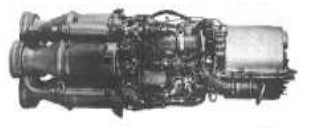
“Reaction Motors LR8-RM-8”
-The LR8 had four combustion chambers of 2,000 lbf of thrust each.
-In the main text the M17G engine is mentioned and shown. Below we see the combustion chamber only, exposed in the exhibition rooms of the Smithsonian Museum in Washington.
-We now have a chamber of the same, somewhat smaller architecture (vertical and inverted) together with the necessary components and tanks.

“RMI JATO assembly”
-RMI obtained one of its first contracts to build takeoff aid engines for the US Navy, such as the well-known Catalina aircraft.
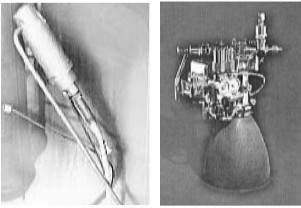
“D50C1 and TD-339”
-The D50C1 was an old one, developed between 1944 and 1948. It was installed on the rotor blade tips of a Pitcairn helicopter.
-The TD-339 is a Vernier used on the Surveyor robotic spacecraft to land on the Moon. It ran on liquid fuels.

“The RMI C1”
-It was known as the Radiamic with only 100 lbf of thrust but it was hardly ever used.
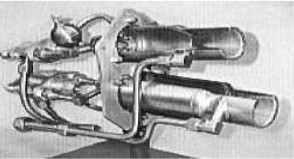
“LR2-RM4”
-This engine was used on the Lark missile with thrusts of 400 + 220 lbf in its two engines.

“XLR-48-RM-2”
-It was designed for the US Navy Corvus missile, although not very effective.
-The engine designs of Reaction Motors inc, (RMI) became Reaction Motors Div (RMD) when they passed to Thiokol Chemical Corp. group (see).
-All of the engines on this page can be seen at the NASM as they have been donated by various builders who owned them.
-There also was the personal lifting rocket motor, known as the “Flying Belt”. In the upper picture it is in the deployed operating position and the in the lower one it is in the retracted position for better movement when not operating.
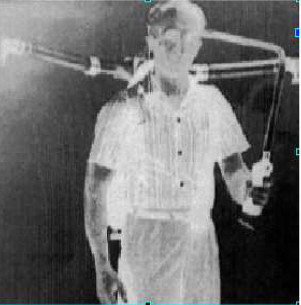
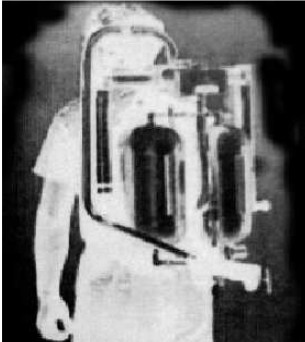
“Two views for the Flying Belt” (PiP)
-We can see the two differentiated tanks for fuel and oxidizer.
From Appendix 9: Rocket engines of this brand, to be added to the main text as required.
-D50G-1 (L-39)
-LR-10-RM-1
-LR-2
-LR-22
-LR-26
-LR-30
-LR-32
-LR-33
-LR-34
-LR-35
-LR-39
-LR-40
-LR-44
-LR-58-RM-1
-LR-6
-LR-62-RM-5
-XLR-22-RM-1 (LR-22)
-XLR-26-RM-1 (LR-26)
-XLR-2-RM-1 (LR-2)
-XLR-30-RM-1 (LR-30)
-XLR-32-RM-1 (LR-32)
-XLR-33-RM-1 (LR-33)
-XLR-35-RM-1 (LR-35)
-XLR-39-RM-1 (LR-39)
-XLR-40-RM-1 (LR-40)
-XLR-48-RM-1 (LR-48)
-XLR-6-RM-1 (LR-6)
From Appendix 10: We found out that the engine used by the Bell X-1 was a Reaction Motors In. LR8 model that was known in the factory as the RMI-6000C4 and also as "Black Betsy" due to the black anti-corrosion color with which it was protected. It ran on LOX/Alcohol.
-Remember that the first plane that passed the sound barrier was the Bell X-1A with the famous pilot Chuck Yaeger at the controls.
-The LR-11 engine was the first engine used by the NAA X-15 due to tuning delays of the LR-99. It was already using the LOX with RP1 (Kerosene).
-The Tu-205 was the XLR-99 (RM2) that ran on LOX/ammonia.
-The Viking rocket engine was the first one to use the "Gimbal" system in the combustion chamber, that is, all of it steerable.
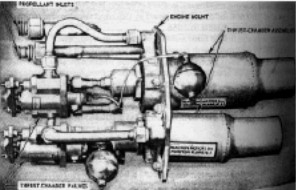
“Lark / SAM engine from RMI”
-The Lark/SAM (Surface-Air-Missile) engine had a double combustion chamber: one as booster and the other one for cruising. It ran on nitric acid and aniline.
-It used both engines up to 0.85 Mach, then the booster was turned off to continue with the cruiser one.
Engines of REACTION MOTORS
Model: BB-1 pulsejet
Arquitecture:
Chambers:
Fuels:
Feed System:
Ignition:
Thrust:
Weight:
Model: CML-2N
Arquitecture:
Chambers:
Fuels:
Feed System:
Ignition:
Thrust:
Weight:
Model: D50C1, -G1 (LR-39)
Arquitecture:
Chambers:
Fuels:
Feed System:
Ignition:
Thrust:
Weight:
Model: Flying Belt
Arquitecture:
Chambers:
Fuels:
Feed System:
Ignition:
Thrust:
Weight:
Model: LR-10, -RM-1
Arquitecture:
Chambers:
Fuels:
Feed System:
Ignition:
Thrust:
Weight:
Model: LR-11, -RM-1, -RM-3 (XLR-11, -RM-5)
Arquitecture:
Chambers:
Fuels:
Feed System:
Ignition:
Thrust:
Weight:
Model: LR-2, -RM-1, -RM-4 (XLR-2-RM-1)
Arquitecture:
Chambers:
Fuels:
Feed System:
Ignition:
Thrust:
Weight:
Model: LR-22 (XLR22-RM-1)
Arquitecture:
Chambers:
Fuels:
Feed System:
Ignition:
Thrust:
Weight:
Model: LR-26 (XLR26-RM-1)
Arquitecture:
Chambers:
Fuels:
Feed System:
Ignition:
Thrust:
Weight:
Model: LR-30 (XLR-30, -RM2)
Arquitecture:
Chambers:
Fuels:
Feed System:
Ignition:
Thrust:
Weight:
Model: LR-32 (XLR-32, -RM-1,-RM-2)
Arquitecture:
Chambers:
Fuels:
Feed System:
Ignition:
Thrust:
Weight:
Model: LR-33 (XLR33-RM-1)
Arquitecture:
Chambers:
Fuels:
Feed System:
Ignition:
Thrust:
Weight:
Model: LR-34
Arquitecture:
Chambers:
Fuels:
Feed System:
Ignition:
Thrust:
Weight:
Model: LR-35 (XLR35-RM-1)
Arquitecture:
Chambers:
Fuels:
Feed System:
Ignition:
Thrust:
Weight:
Model: LR-39 (XLR-39, -RM-1)
Arquitecture:
Chambers:
Fuels:
Feed System:
Ignition:
Thrust:
Weight:
Model: LR-40 (XLR40-RM-1)
Arquitecture:
Chambers:
Fuels:
Feed System:
Ignition:
Thrust:
Weight:
Model: LR-44 RMI-2
Arquitecture:
Chambers:
Fuels:
Feed System:
Ignition:
Thrust:
Weight:
Model: LR-48 (XLR-48, -RM-1, -RM-2)
Arquitecture:
Chambers:
Fuels:
Feed System:
Ignition:
Thrust:
Weight:
Model: LR-58-RM-1
Arquitecture:
Chambers:
Fuels:
Feed System:
Ignition:
Thrust:
Weight:
Model: LR-6 (XLR6-RM-1)
Arquitecture:
Chambers:
Fuels:
Feed System:
Ignition:
Thrust:
Weight:
Model: LR-62-RM-1)
Arquitecture:
Chambers:
Fuels:
Feed System:
Ignition:
Thrust:
Weight:
Model: LR-8, -RM-5, -RM-6, -RM-8
Arquitecture:
Chambers:
Fuels:
Feed System:
Ignition:
Thrust:
Weight:
Model: LR-99 (XLR-99)
Arquitecture:
Chambers:
Fuels:
Feed System:
Ignition:
Thrust:
Weight:
Model: M-17G
Arquitecture:
Chambers:
Fuels:
Feed System:
Ignition:
Thrust:
Weight:
Model: MX-774
Arquitecture:
Chambers:
Fuels:
Feed System:
Ignition:
Thrust:
Weight:
Model: Patriot AK
Arquitecture:
Chambers:
Fuels:
Feed System:
Ignition:
Thrust:
Weight:
Model: RMI-6000C4
Arquitecture:
Chambers:
Fuels:
Feed System:
Ignition:
Thrust:
Weight:
Model: RMI-C1
Arquitecture:
Chambers:
Fuels:
Feed System:
Ignition:
Thrust:
Weight:
Model: ROR
Arquitecture:
Chambers:
Fuels:
Feed System:
Ignition:
Thrust:
Weight:
Model: SLR-99-RM-2
Arquitecture:
Chambers:
Fuels:
Feed System:
Ignition:
Thrust:
Weight:
Model: TD-339
Arquitecture:
Chambers:
Fuels:
Feed System:
Ignition:
Thrust:
Weight:
Model: YLR44-RM-1
Arquitecture:
Chambers:
Fuels:
Feed System:
Ignition:
Thrust:
Weight:


